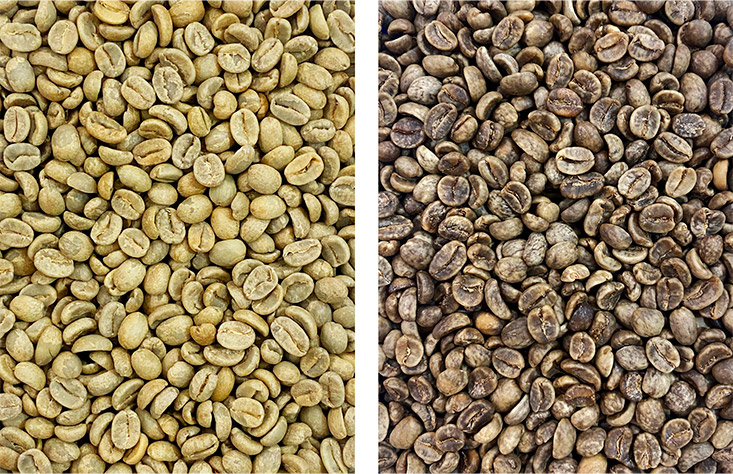There are several methods to decaffeinate coffee, and in this text we will tell you about the most commonly used in the world of specialty coffee. We will explain from natural processes such as Swiss Water or Sugar Cane, to innovative solutions such as the use of CO2. Each technique has its own particularities, but they all share the same purpose: to eliminate caffeine without compromising quality. Today we talk about how coffee is decaffeinated.

Izquierda: Café en verde, proceso lavado.
Derecha: Café verde descafeinado, proceso sugar cane.
Why is coffee decaffeinated?
The main objective of decaffeinated coffee is to offer a caffeine-free option for those who cannot or do not wish to consume caffeine, without sacrificing flavor or the pleasure of a good cup.
Historically, decaffeinated coffee was associated with a flatter profile. However, current methods – more delicate and respectful with the bean – allow the preservation of a large part of the aromas, body and flavor. Especially when starting from coffees of extraordinary origin and quality, the result can be a surprising sensory experience.
Coffee decaffeination processes
We now begin to analyze in depth how coffee is decaffeinated. Here you have the processes with all its phases.
Swiss Water:
- Step 1: GCE (Green Coffee Extract). The green coffee extract created by Swiss Water is key to their process. It is created only once, from fresh water and all the soluble solids in the coffee (minus the caffeine).
- Step 2: cleaning and pre-soaking. Prior to decaffeination, the green coffee is re-hydrated to prepare it for the ideal moisture level for caffeine elimination. This process also removes dirt, dust and silver skin.
- Step 3: elimination of caffeine. The GCE is continuously circulated around the green coffee for a period of 8 to 10 hours, until only 0.1 percent caffeine remains. The caffeine is removed from the GCE through a patented carbon filter system, and the carbon is sent to a regeneration oven to burn off the caffeine for reuse.
- Step 4: the ECG is updated. During decaffeination, the ECG is constantly refreshed and renewed. At the same time, the health of the ECG is continuously monitored to ensure that it can continue to perform at its best. In this way, there is no need to create a new batch of ECG for each new batch of green coffee.
- Step 5: bagging and shipping. When the desired target is reached and 99.99% of the caffeine is removed from a coffee, it is ready to be dried, bagged and shipped to the customer.
EA (EXTRACTING AGENT):
- Step 1:pre-treatment with steam and/or water. This involves wetting the coffee beans to increase the surface area of the bean, open the pores and prepare the cellular structure of the coffee bean, in order to facilitate the extraction of the caffeine in the next stage.
- Step 2:extraction. By means of an extractant agent, which has a selective action against the other components of the bean, and used in a recurrent way, the practical elimination of caffeine is obtained.
- Step 3: elimination of the extracting agent. Reaching the equilibrium in the previous stage, the caffeine is dissolved in the extractant medium and with a separation operation (distillation, filtration by activated carbon, ionic resin,… ) the extractant agent is recovered, which is used in the following operations, and the crude caffeine is obtained.
- Step 4: post treatment with steam and/or water.
- Step 5: The wet decaffeinated coffee is dried to approximately 11%.
CO2:
- Step 1: Green (unroasted) coffee is mixed with water.
- Step 2: When the bean absorbs water it expands, its pores open and the caffeine molecules become mobile.
- Step 3:at this point carbon dioxide (a 100% natural element) is added at 100 atmospheres of pressure over this pure water.
- Step 4: basically water and carbon dioxide mix to create carbonated water. The carbon dioxide acts like a magnet and attracts all the caffeine molecules, which have become mobile.
- Step 5: Once the caffeine is captured by the CO2, it is separated.
- Step 6:CO2 is very selective and does not touch either the carbohydrates or the proteins contained in the coffee bean, which are what give coffee its aroma and flavor once roasted and converted into a beverage.
- Step 7: When the CO2 has finished removing the caffeine, the coffee beans are dried naturally.
- Step 8: CO2 is recycled and the caffeine is sold for commercial uses. E.g. for cola, energy drinks, pharmaceutical use. Remember that there is no such thing as synthetic caffeine.
SUGAR CANE:
Sugar Cane is the name given to the decaffeination process made by Descafecol (Descafeinadora colombiana SAS), a company located in Manizales in the heart of one of Colombia’s largest coffee producing regions. This company uses molasses derived from the abundant production of sugar cane to produce ethanol. This alcohol is mixed with natural acetic acid to create the solvent ethyl acetate.
- Step 1:Coffee destined to be decaffeinated first undergoes a process with water and steam. This raises its humidity and inflates the bean to favor the extraction of caffeine.
- Step 2: It is at this moment that the bean is washed with that ethyl acetate which dissolves the caffeine.
- Step 3: the grains are cleaned with water, followed by steam.
- Step 4: Finally, the grains are dried until they reach 11% moisture content, making them stable and ready for export.
The decaffeinated coffee of Cafés El Magnífico
You already have all the information on how to decaffeinate coffee. Now you just have to try it. Currently, in the El Magnifico catalog you will find Colombian Sugar Cane Decaffeinated. This is a specialty espresso coffee, with a subtle acidity and a heavy body. Ideal for those looking to enjoy an excellent coffee at any time of the day, without the effects of caffeine.